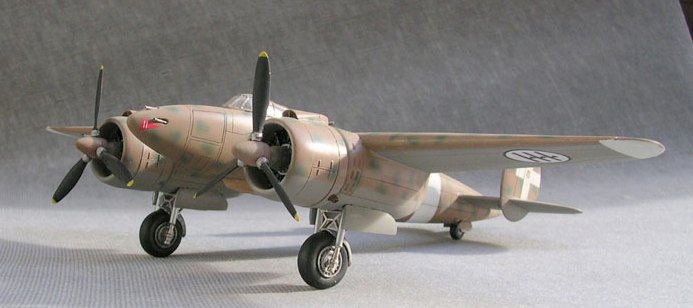
Warrior Models 1/48 Breda Ba.88 Lynx
|
KIT # |
48002 |
|
PRICE: |
$82.55 |
|
DECALS: |
Two options |
|
REVIEWER: |
Chris Busbridge |
|
NOTES: |
Resin kit |

|
HISTORY |
Despite establishing several speed over distance records during its
development phase in the 1930's and luxuriating in an effective
propaganda campaign as a result, this aircraft was destined to be a major
disappointment. Its clean lines made it one of Italy's better looking
aircraft and after such r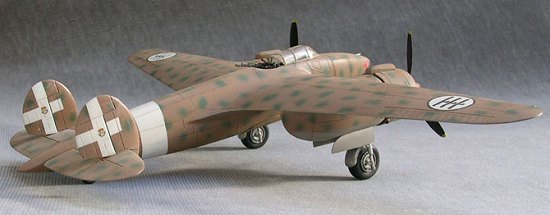 ecord breaking exploits, it was pushed into
full-scale production over and above a rival design, Rosatelli's Fiat
Cr.25 (which was by far the better of the two).
ecord breaking exploits, it was pushed into
full-scale production over and above a rival design, Rosatelli's Fiat
Cr.25 (which was by far the better of the two).
This is where the problems really started. After loading it out with all the necessary wartime paraphernalia, i.e: a nose gun array, a rear gunner and a bomb bay, it's two 1000 h.p. Piaggio P.XI R.C.40's barely mananged to get the aircraft above 300mph. Consequently it was difficult to fly, having all kinds of stability problems, coupled with an extremely poor climb rate.
After several disastrous campaigns in North Africa, they were stripped of their useful equipment, even those delivered direct from the factory and left either as airfield decoys or sent straight to the junk yard. Just over 100 were built. One aircraft that Italy would probably wish to forget. As a ironical footnote, the aforementioned Cr.25, which equipped just one squadron, had an exemplary service record and was well liked by all its pilot's.
|
THE KIT |
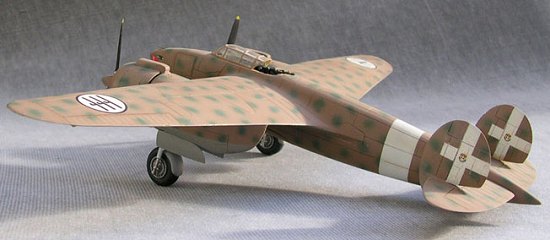 For my money, this resin kit is much a better effort by Warrior than the
Breda Ba.65, although any comments on overall accuracy are hampered by
the lack of good quality plans to check it against. It is not entirely
trouble-free, there is a bad wing/fuselage join, especially on the port
side and the undercarriage pieces are very soft white metal castings,
which was to have repercussions later. The twin tail stabiliser pieces
had a porous surface that was hard to eradicate, the starboard wing had a
pronounced kink that needed heat treatment to sort out, all mating
surfaces needed a lot of cleaning up and there was
For my money, this resin kit is much a better effort by Warrior than the
Breda Ba.65, although any comments on overall accuracy are hampered by
the lack of good quality plans to check it against. It is not entirely
trouble-free, there is a bad wing/fuselage join, especially on the port
side and the undercarriage pieces are very soft white metal castings,
which was to have repercussions later. The twin tail stabiliser pieces
had a porous surface that was hard to eradicate, the starboard wing had a
pronounced kink that needed heat treatment to sort out, all mating
surfaces needed a lot of cleaning up and there was
clear evidence of repair work carried out on some of the parts after they
had been released from the moulds. A minor criticism could be made of the
panel engraving, which was a tad too deep for my tastes.
|
CONSTRUCTION |
The cockpit is made up of a combination of white metal and resin parts and is highly detailed, although the control column was oversized. The location of the majority of these parts needed a bit of guesswork (as well as the cockpit colour), the instruction sheet being a bit vague in this department. Trapping all the parts within the two fuselage halves needed a bit of patience as well. A nice touch was the moulding detail of the seat cushions, which had a luxurious buttoned leather effect.
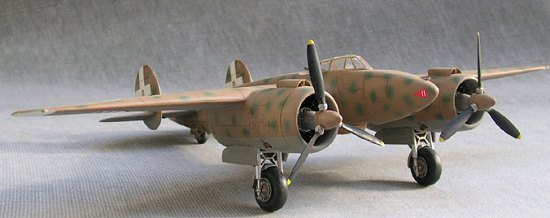 The top and bottom of both wings had extremely fine trailing edges, so
care was taken not to damage them during assembly. The aerofoil section
of each wing were well matched, but did not match the fillet mouldings on
the fuselage! The port side was the worst fit, so Milliput was used to
smooth the join. The large wheel-well fairings were no where to be seen
in the box, so replacement parts were sent for and arrived... eventually.
They fitted reasonably well, but only after a little test fitting. The
engines are nicely modelled and it's worth taking your time dry-brushing
them to bring out the detail, as the large cowlings will make them highly
visible. However, I could not get the resin exhausts to fit as
intended, so small pieces of tubing were used instead, glued in place at
the end of construction.
The top and bottom of both wings had extremely fine trailing edges, so
care was taken not to damage them during assembly. The aerofoil section
of each wing were well matched, but did not match the fillet mouldings on
the fuselage! The port side was the worst fit, so Milliput was used to
smooth the join. The large wheel-well fairings were no where to be seen
in the box, so replacement parts were sent for and arrived... eventually.
They fitted reasonably well, but only after a little test fitting. The
engines are nicely modelled and it's worth taking your time dry-brushing
them to bring out the detail, as the large cowlings will make them highly
visible. However, I could not get the resin exhausts to fit as
intended, so small pieces of tubing were used instead, glued in place at
the end of construction.
The separately moulded white metal propellers were reasonable quality and as they had opposite rotation (not adequately indicated in the instruction sheet) this had to be bourne in mind when gluing them into the resin spinners. As previously stated, the one real weak point of the model, quite literally, is the white metal undercarriage pieces. They were simply not strong enough to support this weighty model. I found this out to my cost when, after final completion, the whole lot just wilted under the strain over a period of a few days or so. I had to make new main units, incorporating the still extant non-supporting white metal parts. The tail planes fitted without a hitch, the only problem was the porous surfaces that only came to light during the painting stage. I applied and re-applied layers of primer, with a touch of sanding between each coat, until they had disappeared. The cockpit canopy was supplied in duplicate, although I did not need to use the spare as it was a relatively simple shape to cut out. The thick framing made it easy to mask as well.
|
COLORS AND MARKINGS |
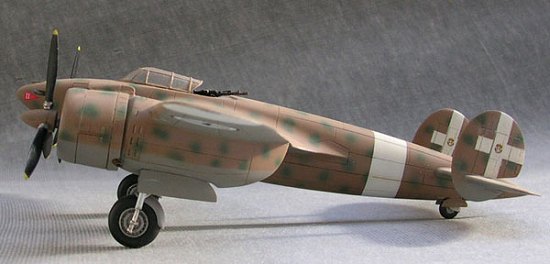 The decal sheet is identical to the one supplied in their Breda Ba65 kit.
I used just the Savoy Crests from the sheet and found spares for the rest
of the markings, using a camouflage scheme not given on the instruction
sheet. I used Xtracolor X104 for the Nocciola Chiaro and Humbrol 91 for
the mottles, with Humbrol 140 used on the lower surfaces. The white
fuselage band and rudder crosses were airbrushed.
The decal sheet is identical to the one supplied in their Breda Ba65 kit.
I used just the Savoy Crests from the sheet and found spares for the rest
of the markings, using a camouflage scheme not given on the instruction
sheet. I used Xtracolor X104 for the Nocciola Chiaro and Humbrol 91 for
the mottles, with Humbrol 140 used on the lower surfaces. The white
fuselage band and rudder crosses were airbrushed.
The aircraft was part of the 7° Gruppo, 5° Stormo based at Castle Benito, Libya in 1940. The small red pennant on the nose was from a SkyModels bomber sheet. Considering the extremely short-lived service record of this aircraft, I felt that any weathering was rather unnecessary.
|
CONCLUSIONS |
As already mentioned, this is a much better kit than the Breda Ba.65 simply because it was much easier to build and appears to be much more accurately and carefully planned. It certainly looks every inch a Ba88. Anyone who has built a resin kit before should find this one quite straightforward, although the undercarriage did pose a problem or two, as did the wing to fuselage join. Overall detail is quite impressive, as is the size of the model.
|
REFERENCES |
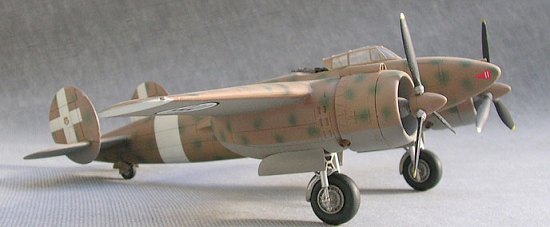 Chris Dunning's "Courage Alone".
Chris Dunning's "Courage Alone".
Colori e Schemi Mimetici della Regia Aeronautica.
"Italian Civilian and Military Aircraft" by Jonathan Thompson.
February 2004 If you would like your product reviewed fairly and fairly quickly, please contact the editor or see other details in the Note to
Contributors.